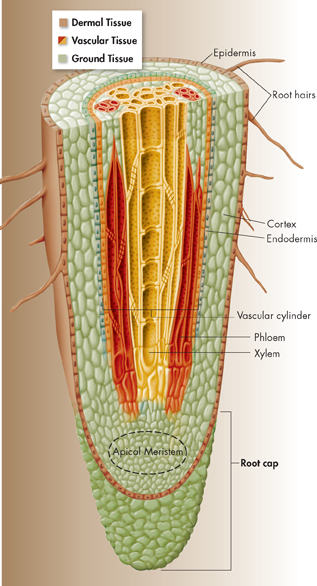ZOOMING IN
ANATOMY OF A ROOT

FIGURE 23–6 A root consists of a central vascular cylinder surrounded by ground tissue and the epidermis.
dAnatomy of a Root Roots contain cells from the three tissue systems—dermal, vascular, and ground tissue, as shown in Figure 23–6.  A mature root has an outside layer, called the epidermis, and also contains vascular tissue and a large area of ground tissue. The root system plays a key role in water and mineral transport. The cells and tissues of a root are specialized to carry out these functions.
A mature root has an outside layer, called the epidermis, and also contains vascular tissue and a large area of ground tissue. The root system plays a key role in water and mineral transport. The cells and tissues of a root are specialized to carry out these functions.
▸ Dermal Tissue: Epidermis The root's epidermis performs the dual functions of protection and absorption. Its surface is covered with thin cellular projections called root hairs. These hairs penetrate the spaces between soil particles and produce a large surface area that allows water and minerals to enter.
▸ Ground Tissue Just inside the epidermis is a region of ground tissue called the cortex. Water and minerals move through the cortex from the epidermis toward the center of the root. The cortex also stores the products of photosynthesis, such as starch.
A layer of ground tissue known as the endodermis completely encloses the vascular cylinder. The endodermis, as you will see, plays an essential role in the movement of water and minerals into the center of the root.
▸ Vascular Tissue At the center of the root, the xylem and phloem together make up a region called the vascular cylinder. Dicot roots like the one shown at left have a central column of xylem cells.
▸ Apical Meristem Roots grow in length when apical meristems produce new cells near the root tips. The root tip is covered by a tough root cap that protects the fragile meristem as the root tip forces its way through the soil. As the root grows, the root cap secretes a slippery substance that eases the progress of the root through the soil. Cells at the very tip of the root cap are constantly being scraped away, and new root cap cells are continually added by the meristem.
 In Your Notebook Relate the role of the root cap to that of your outer skin layer, which loses dead cells at a rate of billions of cells per day.
In Your Notebook Relate the role of the root cap to that of your outer skin layer, which loses dead cells at a rate of billions of cells per day.
Table of Contents
- Formulas and Equations
- Applying Formulas and Equations
- Mean, Median, and Mode
- Estimation
- Using Measurements in Calculations
- Effects of Measurement Errors
- Accuracy
- Precision
- Comparing Accuracy and Precision
- Significant Figures
- Calculating With Significant Figures
- Scientific Notation
- Calculating With Scientific Notation
- Dimensional Analysis
- Applying Dimensional Analysis




